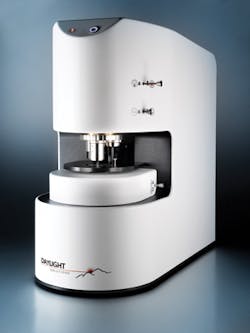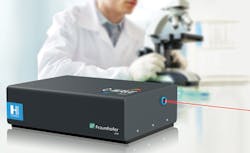CLEO/Laser Focus World 2014 Innovation Awards
Winner: Daylight Solutions' Spero is a quantum-cascade-laser-based infrared microscopy platform with unprecedented resolution and field of view for rapid data acquisition in a compact benchtop footprint.
The 2014 CLEO/Laser Focus World Innovation Awards program, sponsored by Laser Focus World and the Conference on Lasers and Electro Optics (CLEO), honors the most timely, groundbreaking products in the field of photonics and laser science.
Innovation Award entrants are challenged to show how their application, service, or product (launched in the 18 months between October 2, 2012 and April 2, 2014) met several key criteria, including significant impact to the photonics industry, unique functionality, long life expectancy, secure patent position, and above all, an exceptional level of innovation.
For 2014, one winner and two honorable mentions were chosen. The awards are presented each year at the CLEO Plenary Session, which for CLEO: 2014 is Tuesday, June 10 in San Jose, CA. Information on the Innovation Awards can be found online at http://www.cleoconference.org/home/reserve-exhibit-space/cleo-laser-focus-world-innovation-award/.
INNOVATION AWARD WINNER
Daylight Solutions (San Diego, CA)
This year's 2014 CLEO/Laser Focus World Innovation Award winner was Daylight Solutions (www.daylightsolutions.com) with the first laser-based infrared (IR) microscopy platform called Spero. Delivering diffraction-limited (< 5 μm resolution) images with 1.4 μm pixels over a 650 × 650 μm2 field of view spanning a 980–1800 cm-1 wavelength range using a 0.7 NA achromatic refractive objective lens, optional infrared objectives are also available for ultrawide-field-of-view 2 × 2 mm2 images with 4.25 μm pixel size. Spero captures higher-resolution, larger field-of-view, better signal-to-noise ratio images than legacy Fourier-transform infrared (FTIR) microscopy options at 10X faster speeds.
In addition to its "sparse data collection" mode that enables comparable imaging quality at a 40X acquisition speed compared to physically larger FTIR microscopy options (Spero is 3X smaller than commercial infrared microscopes), Spero also includes a "live mode" 30 fps rapid imaging capability for high-definition IR absorption contrast imaging at a user-selected wavelength—a capability that is unprecedented in the IR microscopy community.
Besides its compact footprint, Spero uses a 480 × 480 uncooled focal plane array that eliminates the need for cryogenic cooling, further broadening its versatility compared to bulkier FTIR instruments. Users can develop application-specific data collection routines using a simple scripting language with the ChemVision interface or the instrument can be driven externally with commercial software packages such as Matlab. Spero data is easily exportable to commercially available analysis packages, and a fully programmable precision xyz stage enables user‐defined mosaic spectral imaging through the ChemVision interface.
HONORABLE MENTIONS
Aurea Technology (Besançon, France)
The first of two 2014 CLEO/Laser Focus World Innovation Awards' honorable mentions (in alphabetical order) was for TPS_1550, the first commercial twin-photon source from Aurea Technology (aureatechnology.com), a fully integrated (pump source, crystal, optics, electronics, and software) 1550 nm photon pair source for scientists and engineers developing quantum optics technologies that creates photons on demand with a spectral brightness of more than 105 photons/s/pm and a selectable 6 GHz to 7 THz emission bandwidth with < 2 pm central wavelength drift.
This entangled-photon-pair source replaces existing complicated setups that are typically devised by laboratory scientists. The TPS_1550 is instead a compact, self-contained instrument that fully integrates all the necessary optical fiber elements, electronics, and software to reproducibly deliver photons on demand, controlled by an easy-to-use PC-based user interface with touch-screen front panel, fast USB connection, and available DLL libraries to interface with LabVIEW or C++ software. In addition, the twin-photon source is fully compatible with Aurea's two-channel near-infrared photon counting module.
HÜBNER GmbH (Kassel, Germany)
The second honorable mention was awarded to HÜBNER GmbH (www.hubner-germany.com) for its C-WAVE optical parametric oscillator (OPO), the first coherent continuous-wave source with parametric oscillation and frequency doubling capability combined in one cavity for tuning across the visible range from blue to red without requiring any change of laser materials or components.
C-WAVE combines two nonlinear processes (an OPO and second harmonic generation or SHG) in a single cavity where a 532 nm laser pumps a periodically poled nonlinear crystal, generating near-IR signal and idler waves. These waves then pass through a frequency doubling crystal where SHG of the signal creates blue to green colors while the idler conversion spans the green-to-red range. Computer control merges the range seamlessly for a groundbreaking user experience that simplifies spectroscopy, photochemistry, biomedical uses, and myriads of additional photonics applications.




